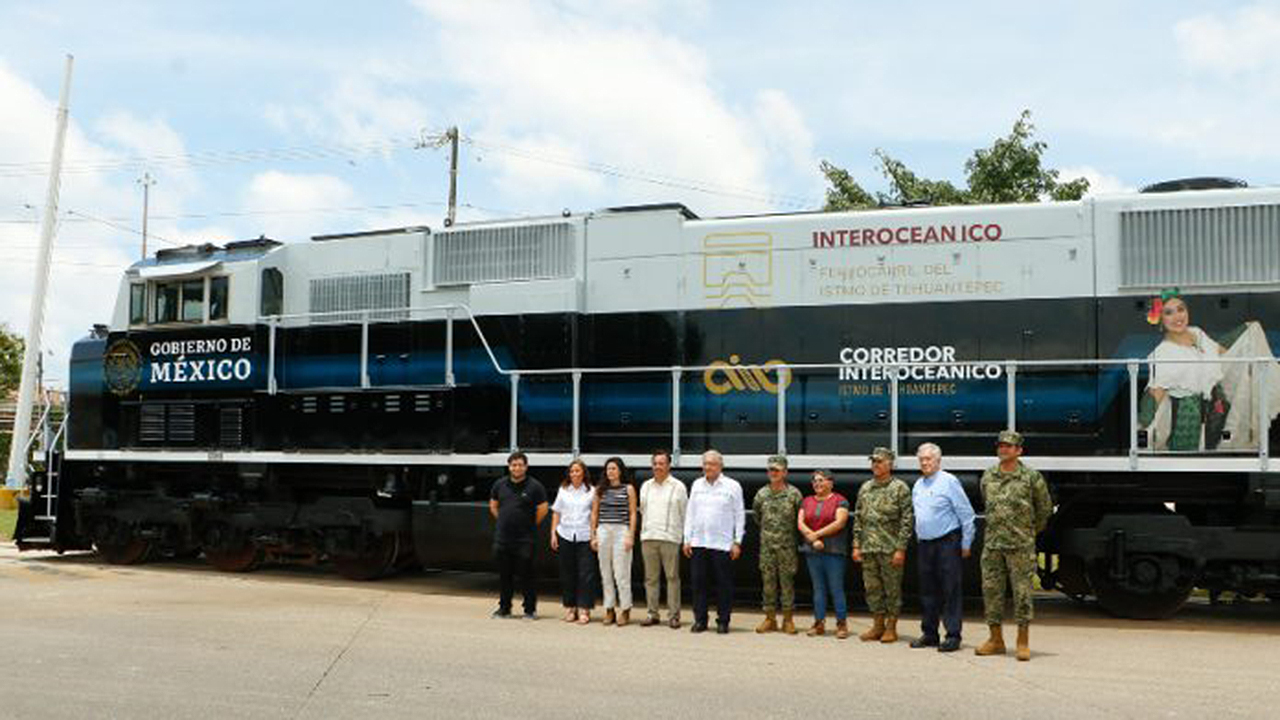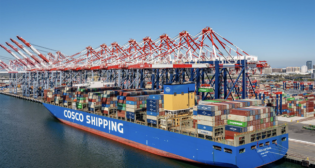
Mexico: CIIT Nears Test Operations (Updated)
Written by William C. Vantuono, Editor-in-Chief
Mexico President Andrés Manuel López Obrador (fifth from left) presented the Interoceanic Corridor of the Isthmus of Tehuantepec’s first locomotive, an EMD SD70M originally built for Union Pacific in 2001. CIIT photo
The Interoceanic Corridor of the Isthmus of Tehuantepec (CIIT, for Corredor Interoceánico del Istmo de Tehuantepec), expected to undergo a “supervised test run” on Sept. 17, received a recent visit from Mexico President Andrés Manuel López Obrador (AMLO). The President, who will leave office on Sept. 24, 2024, was touring what is widely regarded as his most important transportation project, with the potential to offer a long-term boost to the Mexican economy and develop the industry and economy of the country’s largely rural, economically poor southern states. CIIT, Mexican officials say, has the potential to be a “cheaper, faster alternative” to the Panama Canal.

AMLO presented CIIT’s initial locomotive, ex-Union Pacific 4378, an EMD SD70M built for UP in 2001, released after lease expiration, and rebuilt by Metro East Industries in East St. Louis, Mo. The unit is in a Government of Mexico livery featuring women dressed in the traditional clothing of Oaxaca, Veracruz, Chiapas and Tabasco. (Editor’s Note: Retired Union Pacific Senior Director Locomotive Engineering and Railway Age Contributing Editor Mike Iden’s signature was on the acceptance certificate for 4378 when it was delivered to UP.)
Under the supervision of Mexico’s Secretariat of the Navy, the 188-mile (303 km) CIIT is being built to connect the Pacific and Atlantic Oceans with a mixed-used (freight and passenger) railroad crossing the Isthmus of Tehuantepec from Coatzacoalcos, Veracruz to Salina Cruz, Oaxaca on mostly long-neglected right-of-way. The project also includes modernization and growth of the ports at Coatzacoalcos and Salina Cruz, and of the Minatitlán and Salina Cruz oil refineries in southern Mexico. It also plans to attract private investment through creation of 10 industrial parks in the Isthmus area. At Coatzacoalcos, the railroad connects with CG Railway LLC, the rail ferry service from Mobile, Ala., a joint venture of Genesee & Wyoming Inc. and SEACOR Holdings Inc. One section of CIIT goes to Palenque, Chiapas, where it will connect with the Maya Train (Tren Maya), another government railway project.
In 2021, the Biden Administration announced that it would “aim to create US$250 million in new investment and sales in southern Mexico.” The funds will mainly go to the agriculture and eco-tourism sectors but also infrastructure initiatives.The U.S. Trade and Development Agency (USTDA) will receive bids until Oct. 6 to prepare a feasibility study for an intermodal rail terminal in Mexico’s Chiapas state. The process is open to U.S. firms that are “qualified on the basis of experience and capability,” the agency said on its website. Interested participants can register here. Funding for the studies will come from USTDA, which on July 24 granted the Chiapas SET (Secretaría de Economía y del Trabajo, or Economy and Labor Ministry) US$960,000 to help it plan the project.
“USTDA’s study will identify and select the site for the intermodal rail terminal, develop technical specifications, and conduct economic, financial and market analyses to demonstrate the effectiveness of integrated freight between road and rail carriers,” the agency said.
SET envisions the intermodal terminal to reduce road freight transport in Mexico’s southeastern states, much of which originates or terminates in. Central America. The CIIT project also involves modernization of the 285-mile (459-km) “Line K” that connects Ixtepec in Oaxaca with Ciudad Hidalgo in Chiapas, near the border with Guatemala.




